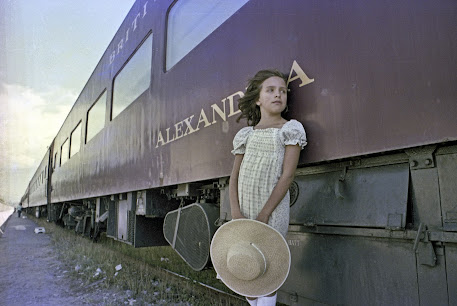 |
| Alexandra Elizabeth Waterhouse-Hayward & The Royal Hudson 1979 |
Since I was a child in Argentina railroads have been part of my life. The British built an excellent system that goes into the interior provinces from Buenos Aires. Most of the city neighbourhoods are linked to the downtown core of Buenos Aires through electric and most recently (unfortunately) diesel engine locomotives. The cavernous terminals all connect to the efficient and clean subway system.
If you want to travel into the interior you can fly, take buses (with “flight” attendants) or the trains.
To me the scandal in British Columbia is that unless you own a car you cannot travel into the interior. My eldest daughter has lived in Lillooet for 17 years. It is connected to Vancouver by incredibly curvy roads. Those who live in Lillooet, if they want to go anywhere else, they better own a car.
 |
| Hilary and Alexandra - Royal Hudson 1979 |
Lillooet has a lovely train station. No trains stops there.
As an Argentine, now a Canadian citizen, I see this communication debacle as one of a province and city with no vision for its future. The Golden Gate Bridge was inaugurated in 1933 with 6 lanes. Now depending on the traffic it is four lanes in one direction and two in the other.
The Lion’s Gate Bridge was built in 1937 with two slightly wide lanes. When traffic increased as it had to those two lanes were converted into three. Now we must suffer the consequences of one lane in one and two in the other.
We could point out the same situation in the Richmond tunnel.
And it has taken forever for any decisions to be made on how to relieve the tunnel's congestion.
Our skytrains meet at very few crossings unlike the NY City subway, London Underground and Buenos Aires Subte.
Perhaps it all began when Premier Gordon Campbell sold BC Rail to CN. Shortly after trains going north to Whistler and Lillooet were literally stopped on their tracks. The pleasant Budd (diesel) trains that went to Whistler and beyond were no more.
I worked for many years for Canadian Pacific Limited. I photographed trains, trucks, airplanes, real estate, etc. I was the last person to photograph the Royal Hudson locomotive when it was being serviced at the old Drake Street Roundhouse. The Royal Hudson was a magnet for tourism on its almost daily trips to Squamish. The powers making the decisions with a poor take on the future decided that to repair the boiler of the Royal Hudson was too expensive, on the side, in Squamish was its sister engine. It was being restored so the lofty head of CP Rail could use it to take his friends for a ride.
I cannot understand how government, after government, be it Liberal or NDP has ignored how the interior is left to fend for itself in complete isolation.
A Roman Catholic bishop born in Spain, Vasco de Quiroga (1470/78 - 14 March 1565) presided in the area that is now the State of Michocán. Quiroga, who read Latin, read Tomas More's Utopia shortly after it was published in 1516. When Quiroga arrived in Michoacán, he employed a strategy of congregating indigenous populations into congregated Hospital-towns called Republicas de Indios, organized after principles derived from Thomas More's Utopia. Then in each of these Repúblicas he taught the population different trades. To this day if you want to purchase lovely copper pots, etc you go to Santa Clara del Cobre. Paracho, Michoacán is famous for its guitars.
Nobody then would have identified this good bishop as a communist. But after studying his record one must come to the conclusion that he preceded socialism quite a few centuries before Marx had that brainwave at the London Library.
When I visit my daughter in Lillooet I drive carefully. I have determined that the curves to Squamish, the curves from Whistler to Pemberton and that one continuous curve to Lillooet can be navigated more safely, particularly in the rain with snow tires. I now do not drive with summer or all seasons.
When you arrive at Lillooet you are met up by a sign that says Lillooet – Guaranteed Rugged.
I would bet that if Mr. Quiroga were around he would suggest that the town develop a boot industry. I would buy a “guaranted rugged” Lillooet pair of boots or perhaps some Indigenous-designed flannel shirts.
Just about every town in Mexico’s interior is known for some comestible or handicraft. If you go to Mérida you will find light cotton clothing. Guadalajara is famous for its Talavera pottery as good as any you could find in Spain. My dear Veracruz, where I lived for some years, is famous for its sea-food, cigars and I believe the best coffee in the world that is served at the Café de la Parroquia.
Why it is that we have no industry in our interior towns that is beyond just tourism for Vancouver city folk?
Going back to the train to Whistler, it is obvious why the train was single tracked. There was little room for another. But there are areas where you could have double tracks and trains could linger (as trains are known to do) in wait for a clear right of way.
When my Rosemary and I spent a week in Venice we took the vaporettos everywhere. I cannot understand why nobody has put forward a vaporetto type of craft that might begin in Deep Cove with lines going to North Vancouver and West Vancouver and another on the other side of Burrard inlet servicing Port Moody, Burnaby, East Vancouver all the way to downtown Vancouver. These vaporettos might then go all the way to UBC. Is this idea so far-fetched?
Do we have any women or men (people if the previous offends) with vision in a city with such a poor memory for its past?








